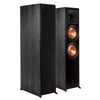
Essential Features to Consider When Choosing Floorstanding Speakers - Joe Audio
, by Haim Deutsch, 4 min reading time

, by Haim Deutsch, 4 min reading time
Enhancing the audio quality of your setup can be achieved with floorstanding speakers, also known as tower speakers, due to their tall profile that delivers powerful sound.
However, choosing the right pair requires careful research to ensure optimal performance. In this blog post, we have outlined essential steps for selecting the perfect floorstanding speakers, covering crucial factors such as sound quality, size, amp compatibility, and cabinet design, to help you make an informed decision.
It can be challenging to find floorstanding speakers.
Although there are many inexpensive options, they are bulky, heavy, and more expensive than the majority of other speaker types.
Why then would you choose them? The simple solution is sound quality. The best audio quality in the speaker industry typically comes from floorstanding speakers.
They can get louder and more powerful than other speakers thanks to their large size and amplified drivers, and they also produce richer, more potent sound.
Before making a decision, it's important to have a general idea of the sound you want. Do you want to hear music the way the composer intended?
If so, it would be wise to seek out speakers who have a reputation for objectivity and clarity; you can see a number of options in our exhaustive list of speaker reviews.
It's worth considering this if you prefer your music to have some personality, perhaps with some serious bass, and choose a model that emphasises the low end.
The good news is that floorstanding speakers can handle almost any genre of music, and finding a pair that meets all of your needs is not difficult.
Size has already been brought up, and for good reason.
Floorstanding speakers are not designed to be lightweight or portable. If you purchase one, it's likely that you won't be taking them camping; however, if you do, send us pictures, because that's awesome.
When it comes to tower speakers, size does matter. Better detail and clarity can be produced by speakers with larger drivers. To get the best performance, look for larger cones.
Greater air movement provided by larger speaker cabinets results in improved bass response. A speaker can handle a wider frequency range when it has larger drivers and a larger cabinet.
All sound is made up of various frequencies. These frequencies are typically divided into three categories in audio: the low-end (bass), the mids (where vocals can be found), and the highs (think snares and violins).
A single speaker driver can output all of these without too many issues, but when you have two or more drivers to share the load, sound quality dramatically improves.
It implies that one driver can concentrate on the lows and mids while delegating responsibility for the highs to another driver. By the way, the former is referred to as a woofer and the latter as a tweeter.
Speakers on the floor can be extremely loud. They must be moving a lot of air because sound can only occur when the air is moving.
This means that the speaker's cabinet, or outer housing, is extremely significant. You definitely don't want it to rattle loudly if it's too flimsy or poorly made.
But how can you be certain that the speaker you pick won't do this?
The good news is that it's unlikely you'll require to. Even affordable loudspeakers now have cabinets that are sturdy enough to withstand vibrations at all but the highest volumes because speaker design and materials have advanced to that point.
Even at budget-friendly price points, materials like reinforced MDF and technology like internal baffles, resonance chambers, and acoustic tuning have become standard.
For example, Klipsch RP-6000F Floorstanding Speakers deliver incredible acoustic clarity for a premium listening experience.
As we've previously mentioned, larger speakers generally produce louder sound due to their increased size. However, if you're seeking an objective measure to determine a speaker's ability to deliver loud audio, sensitivity is a key factor to consider.
Sensitivity refers to the number of decibels a speaker can output at a given power level, typically measured at 1 milliwatt. A higher sensitivity rating indicates a louder speaker, making it a useful metric to assess a speaker's performance in terms of volume.
In conclusion, when it comes to selecting the best floorstanding speakers for your audio setup, sound quality, size, driver configuration, cabinet design, and sensitivity are all crucial factors to consider.
Floorstanding speakers are known for their exceptional sound quality, with the ability to deliver powerful, rich, and detailed audio. The size of the speaker matters, as larger drivers and cabinets can result in improved bass response and wider frequency range.
Opting for a two or three-way configuration can further enhance sound quality by allowing different drivers to handle different frequencies.
Cabinets that are sturdy and well-designed can minimize vibrations and unwanted rattling. Lastly, sensitivity is an important parameter to determine a speaker's ability to get loud.
By considering these key features, you can make an informed decision and choose the perfect floorstanding speakers to elevate your listening experience to new heights.